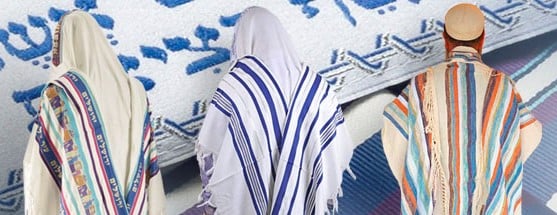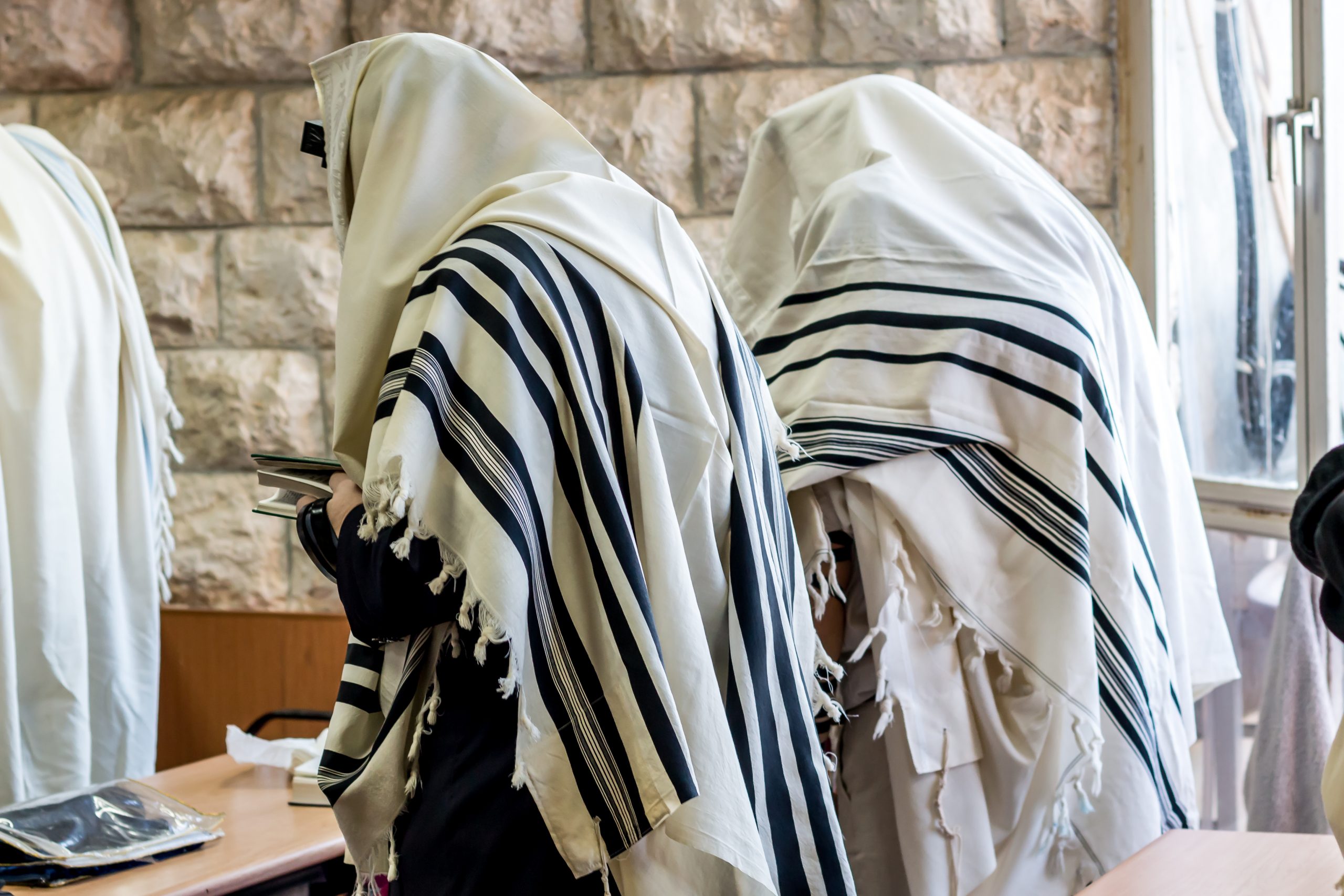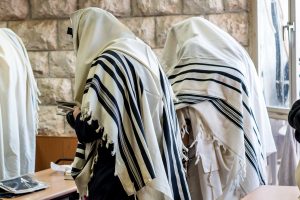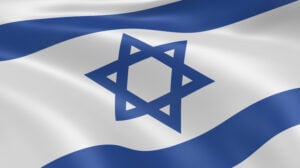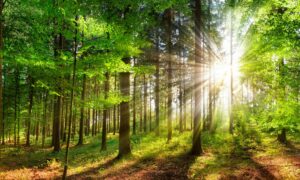The Tallit is perhaps the most recognizable and universal Jewish ritual object, with a rich history going back millennia. Despite its long history, plenty of questions regarding the Tallit remain, even for people who have been wearing it for years!
This guide will tell you everything you need to know about the Tallit, including its origins, the different types, and how to pick the Tallit that is right for you.

Tallit versus Tallis
Tallit is a Hebrew term, pronounced like combining the words tall-eat, and it most commonly refers to the ritual prayer shawl worn by Jews during joyous occasions such as weddings and during morning prayers. It comes from an Aramaic word that means “to cover.”
Some people say “Tallis” (pronounced tall-iss) instead – this is simply because many Ashkenazi Jews pronounce the Hebrew letter Taf (ת) like an S, while many Israeli, Sephardic, and Mizrahi Jews pronounce the Taf like a T. The plural of Tallit in Hebrew is Tallitot, and the plural of Tallis is Tallisos or Tallisim.
Where does the Tallit come from? And why do Jews wear it?
The basic origins of the Tallit come from a commandment found in the Torah: “And G-d spoke to Moses saying: Speak to the Children of Israel and tell them to make for themselves fringes on the corners of their garments throughout their generations, and they should place on the corner fringe a blue thread. And they should be your fringe, and you should see it and remember all of God’s commandments and do them and you shall not wander after your hearts and after your eyes that you profane yourselves after. In order that you will remember and do all of My commandments and so you will be holy for your God.” (Numbers 15:37-40).

Many interpret this verse to mean that the Tzitzit are meant to serve as a physical reminder of the commandments and our obligations to fulfill them. The significant detail here is that the mitzvah (commandment) applies to a four-cornered, woven cloth garment.
The style of dress in Biblical times was for people to wrap themselves in rectangular garments, but as styles changed over time, less and less people were wearing four-cornered garments every day.
The Rabbis decided, therefore, to make it a special duty for us to go out of our way to continue wearing four-cornered garments in order to obligate ourselves in this time-honored and deeply significant mitzvah. They instituted two different garments for this purpose.
The Two Types of Tallitot
- The Tallit Katan (the small Tallit, often referred to as the Tzitzit or Arba Kanfot). It is a small rectangular garment, like an undershirt, with the requisite ritual fringes on the corners. It is worn by many observant Jewish boys and men under their regular clothing all day, every day.
- The Tallit Gadol (the large Tallit, often simply referred to as the Tallit). The Tallit is essentially a large rectangular piece of cloth with Tzitzit added to each of its four corners. It is worn as a shawl, generally only in synagogue during morning prayer services, as well as at some special lifecycle events.
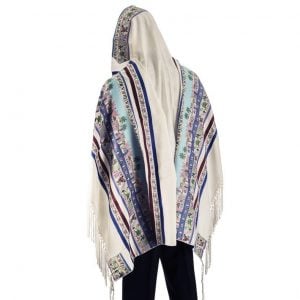
The classic material for a Tallit is pure wool, and it remains the only choice for the most traditional-minded worshipper. Even here, of course, the options are almost endless, with many colors and color combinations to choose from. It should be noted that according to some interpretations of Jewish law, wool is the only kosher (appropriate) option.
Tallitot are also very popular in acrylic and other synthetic materials. These can be made into very traditional-looking products at a fraction of the cost of wool, or into completely modern and unique styles, patterns, and designs. Other modern Tallitot can be made from cotton and even pure raw silk.
Some of Israel’s top artists, including Yair Emanuel and Ronit Gur, use Tallitot as a canvas to express their creativity and their inspiration from our 3,000-year-old tradition. Lace, embroidery, and vibrant colors are among some of the features used on these artistic Tallitot.

Wait… what about the blue string mentioned before?
Good question! According to piece of Torah mentioned previously, G-d said, “They should place on the corner fringe a blue thread.” So today, why don’t most Tallitot have that blue thread?
The blue thread, also known as the tekhelet, doesn’t refer to just any shade of blue. In ancient times, tekhelet was a treasured and special blue dye that came from a chillazon. There are a lot of different opinions about what a chillazon is, but most scholars and rabbis agree it was some sort of Mediterranean fish or snail. Since there is so much uncertainty surrounding the blue dye and string, we haven’t been obligated to follow that part of the commandment for the last 1,400 years or so.
Nonetheless, a formula for tekhelet dye was discovered by scholars in recent decades and is believed by some to be the original tekhelet, and it is permissible to add strings dyed according to this formula to one’s Tallit or Tzitzit. Tallits aren’t generally sold with the blue strings added, but you can buy them separately and add them on yourself, or ask a rabbi or teacher to do it for you.
When do people start wearing a Tallit?
The answer to this question varies greatly by community and their interpretation of Jewish law. In some Orthodox communities, it is common to see young boys who are wearing a tallit katan with Tzitzit dangling from under their shirt. In traditional Ashkenazi communities, the most common custom is that a man does not wear a tallit gadol until he is married. In many Reform and Conservative communities, Jews of any gender start wearing the Tallit at their Bar or Bat Mitzvah.
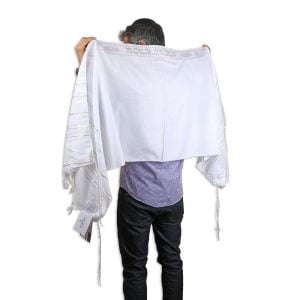
Do women wear the Tallit?
In the last few decades, many women have begun wearing the Tallit at synagogue services, and many young girls wear them at their Bat Mitzvahs. This is more common in Reform and Conservative Jewish communities.

To meet the demand, Israel’s best and most creative Judaica designers often offer Tallitot made especially for women, featuring feminine motifs like pomegranates, flowers, and colorful Tree of Life designs, as well as bright and bold color schemes and delicate materials like silk, polysilk, and organza. Tallitot designed specially for women also tend to fit better on a female body than the traditional Tallit.
If you are a woman and you want to take on the mitzvah of wearing a Tallit, it is best to check with your rabbi to find out more about your community’s norms regarding when to wear a Tallit and which material to choose.
How do I choose a Tallit?
Tallitot make great gifts for a young child coming of age who will have their Bar Mitzvah or Bat Mitzvah in the coming year. Tallitot can also be used as a chuppah at a wedding, or can make a wonderful gift for a friend or family member who has just completed converting to Judaism.
Our store has hundreds of Tallitot and Tallit accessories to choose from – whether you’re looking for a more traditional style made right in Israel by famed Tallit makers Talitnia, or something more modern like the fun styles designed by Jerusalem artist Yair Emanuel. If you’re feeling overwhelmed, don’t worry – our Tallit buying guide will help you narrow down your choices and find the perfect Tallit.
Good luck and happy shopping!
